‘Past Lives’: A Tour of New York City With Greta Lee and Celine Song
- Oops!Something went wrong.Please try again later.
- Oops!Something went wrong.Please try again later.
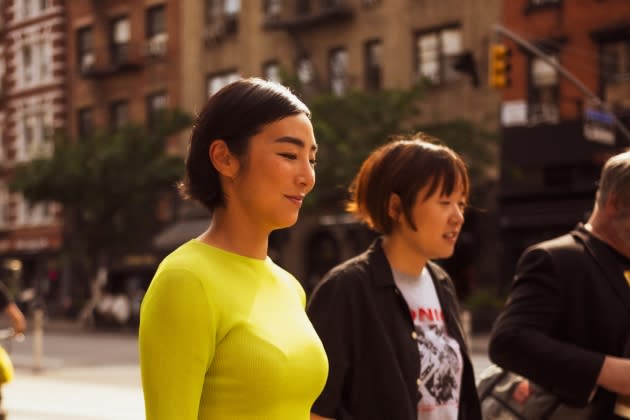
Greta Lee is squinting in the sunlight, staring intently at a street corner in the East Village. There’s a look of intense concentration on her face. “Wait, is that…”
“Yeah, that’s the corner,” director Celine Song says.
More from Rolling Stone
“I thought it was!” Lee replies, lighting up. “We’d just finished doing the last scene — not the last last scene, but the big scene at the end, and it was something like four in the morning, and we were just exhausted, and we all walked over right past that corner and drank, like, a box of beer.”
“And this is the street we shot on,” Song says, pointing in the opposite direction. It looks like any street you’d encounter if you went idly strolling through New York’s downtown, but as the two friends turn the corner and walk a few more steps, Lee takes a deep breath. She knows “the stoop” is right down there, roughly 100 yards away, past the handful of storefronts and the garage door that used to have the Dopey mural painted on it.
“I’m not going to lie to you, I’ve got a little bit of PTSD right now,” the actor says. She sounds like she’s joking, in the slightly sarcastic, extremely deadpan way that Lee — clutch supporting player, longtime comic sidekick, stealth scene-stealer — has made her signature way of spinning a putdown or a punchline. But her expression suggests otherwise. A minute later, she and Song are standing across the street from a nondescript set of stairs leading up to a nondescript door. “From right there,” Lee announces, pointing her finger at the stoop, before swiveling to her left and focusing on a fence plastered with flyers, “to right there… that was it for us. That stretch was our everything.”
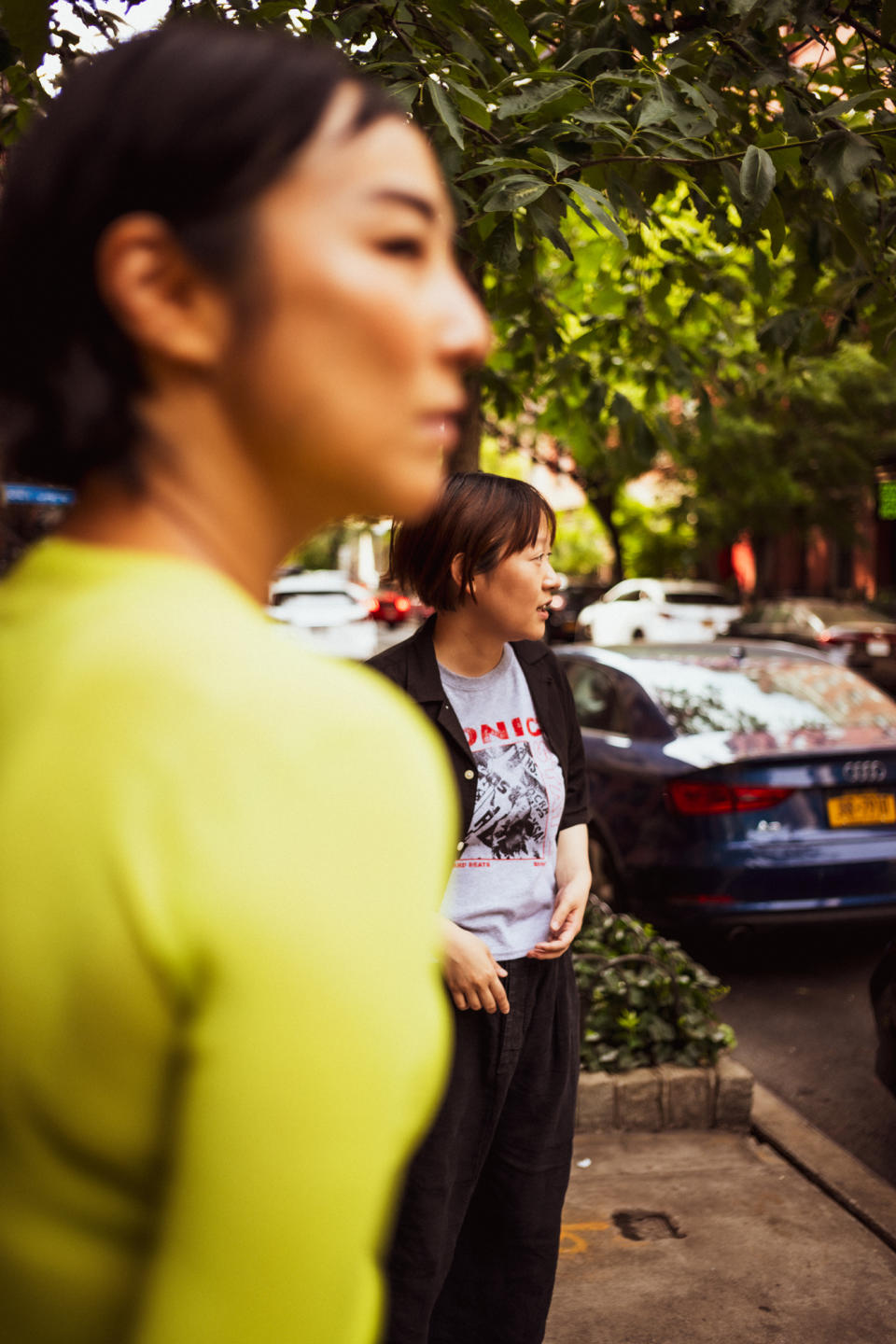
If you’ve seen Past Lives, the film that Song and Lee made together in the summer of 2021 and immediately became the single most praised movie in recent memory after its premiere at this year’s Sundance, then you know why this typical Downtown New York City avenue is a big deal to both of them. (It opened wide across the U.S. on June 23rd.) A tale of two South Korean childhood sweethearts who are separated when one moves away, reconnect online in their mid-20s and eventually meet face to face again in their 30s, it’s the sort of character-driven drama that slowly casts a spell on viewers before reducing them to weeping human puddles. And while it’s an intensely personal story for both the writer-director and her star, the movie is also the type of emotional journey that succeeds in striking a chord with anyone who’s had to navigate the “what-ifs?” of a well-lived life.
It’s also very much a New York movie, a city that Lee once lived in before relocating to her hometown of Los Angeles and Song still resides, which is why the actor and the writer-director have agreed to meet up and give a walking tour that winds through several locations used in the film. Other than a brief preamble, Past Lives doesn’t technically start in NYC; it really begins in Seoul, where a 12 year-old girl named Na Young and her best friend and schoolmate, Hae Sung, are gently navigating a case of puppy love. Na’s family is in the process of emigrating to Canada, however, and shortly after spending an afternoon together at a park, the tweens say goodbye. Na and her sister begin their adolescence in Toronto. Hae Sung continues to live the life of a typical South Korean teen.
Na’s origin story is essentially Song’s origin story as well, since she, too, had harbored a crush on a boy she knew as a kid in Seoul before her own family headed west and moved to the Great White North when she was 12. Like the twentysomething version of the character — who now goes by Nora Young — Song eventually made her way to New York City and became a playwright. There are more real-to-reel similarities between the filmmaker and her protagonist as well: Both Celine and Nora will get a message from their old crush on social media, which starts an intense transatlantic correspondence, but nothing more. Both Celine and Nora will meet their future husbands, who are also writers (Song is married to Justin Kuritzkes, who penned Luca Guadagnino’s upcoming film Challengers; his screen counterpart is named Arthur), at artists’ retreats. And both Celine and Nora find themselves sitting in a bar one evening with their spouse on side and their former object of affection, visiting from out of town, on the other, briefly bridging two distinct segments of their lives.
“That all really happened to me, yeah,” Song says, as she and Greta meet me at a fountain in Madison Square Park. This is where they filmed the reunion of the now-married Nora, played by Lee, and the older version of Hae Sung, played by the German-born actor Teo Yoo (Decision to Leave), as they set eyes on each other for the first time in 24 years. “I’m a natural-born procrastinator, so even though I thought, ‘Maybe this is something’… it just went into my growing pile of maybe-this-is-something ideas. I thought it was interesting to me. I didn’t think anyone else would care. But it sort of stubbornly stuck around.
“When I started to tell my friends the story of what it was like to sit between these two people, however,” she continues, “I noticed that our friendships somehow felt deeper to me after I’d tell it. They’d tell me their own stories like this, too. Not ones about their past crushes or anything, but everyone seemed to have someone who brought out a past version of themselves. I thought, OK, I’ll try to write this. I have no idea how to make it work, though. This will take me forever. Then I remembered having the sensation that people were watching us at the bar, and trying to figure out what our story was. ‘That’s a structural scene, maybe I’ll just start with that…’”
“Tell him how long it took you to write it after you figured that out,” Lee says, prompting her.
“A month,” Song says, sheepishly. “It took me a month.”
“A month,” Lee repeats, theatrically glaring at her friend in a way that’s familiar to anyone who’s seen the actor in TV series like Russian Doll and The Morning Show. Song knew Lee’s work from those shows, and small but memorable roles in movies like the Amy Poehler/Tina Fey comedy Sisters. Lee, in turn, had seen a remote performance of Song’s 2019 play Endlings, and was blown away by the writing. She’d been given the script for Past Lives early in the process and loved it, but Song was initially dead set on three things in regard to the project: It would be a movie and not a play, despite her background in the theater and the fact that she had zero filmmaking experience; she wanted to shoot it on actual 35mm film; and the part of Nora would be played by someone in their late 20s.
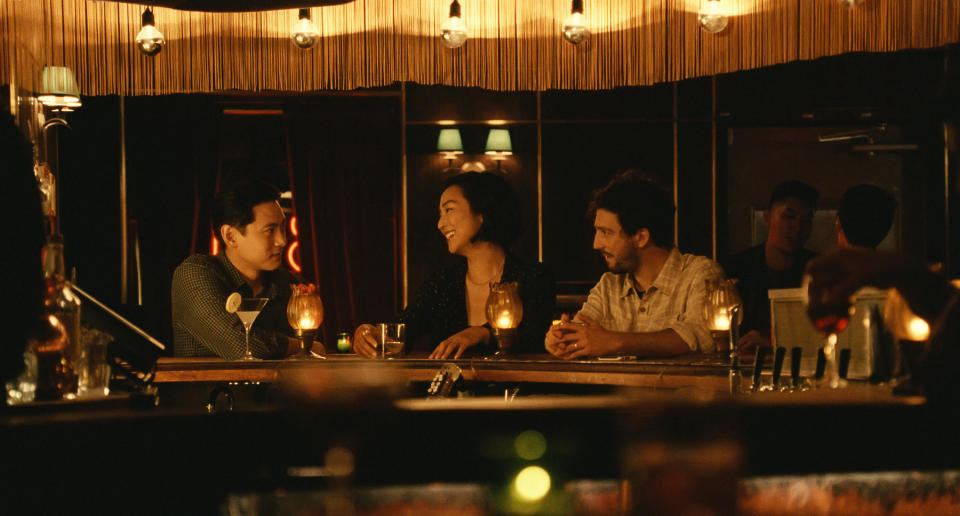
“The film aspect was because it’s about time and places,” Song admits. “The fact that Seoul and New York are not just so far apart but so distinct — that’s a fundamental part of why Hae Sung and Nora can’t be together in their twenties. So you could recreate that in a theater, but with film, you’d get audience members to really see and hear the difference. I sent sound teams to here and Seoul, and just the sounds of each city — they’re worlds apart.
“As for the casting bit…” she says, laughing. “I was 29 when my friend came to visit. So I was stuck on thinking that it had to be someone in their late 20s. Then things shift as you get older, and I started to get a better sense of what the movie was. My options opened up a lot after that.”
Lee had basically given up on the part, when she received an email with a Zoom link and a question: Are you free right now? “Complete spur of the moment,” Lee recalls. “I had no time to prepare, or sort of artificially come up with a dialect or put on a mask of what I my idea of a ‘Seoul person’ would be. It was just, Ahhhh, hi, how are you… aaaaaannnnd here’s what I’ve got!”
“Which was perfect!” Song says. “Because I had you read the lines in Korean, and the way you spoke them… it’s hard to pick up if you don’t speak the language, but the way you were talking, it was like you were a 12-year-old. And that was the moment I completely saw Nora! Because when she’s talking to Hae Sung, even though they’re older, it’s like they revert back to their last moment together. That’s the contradiction that’s in all of us: We are both the kid we once were and the adult we are now. And that’s what I heard. It just opened everything up.” A pause. “Plus I knew you could do comedy, which meant that you could do anything. Like Adam Sandler.”
“And I am often told I am the Adam Sandler of my generation, so it all makes sense,” Lee deadpans. Then she gestures to the fountain in front of us. “Being back here reminds me how you set the reunion scene up. Teo and I were not allowed to touch each other during rehearsals or run-throughs. She wanted the moment on camera that the characters hug each other after 24 years of not being next to each other to be the first physical contact he and I had as actors. When you first told me that, I was just like, ‘OK …really?’ Like, who cares? And then it created this pressurized feeling of thinking about the nature of yearning, and longing, and what it means to actually touch somebody. We had separate trailers on either side of the park; they brought me on to the set and sort of hid me out of sight from him.”
“I needed you both to feel like you were hugging a ghost,” Song says.
“Right! Then, when the cameras are rolling and we actually saw each other and Teo and I hug for the first time… it was just all like, whoosh,” Lee says. “It created this incredible, emotionally heightened moment that was like, oh, this is what it really feels like. And it was that kind of consideration for what we do as actors, and the foresight to handle these things with such sensitivity — it was paramount to helping me to establish this deep, decades-long history and childhood friendship with another performer. It was such a huge help.”
So that first take is the one in the film? “No, I used the second one,” Song says. “It turned out better.” She and Lee both simultaneously crack up.
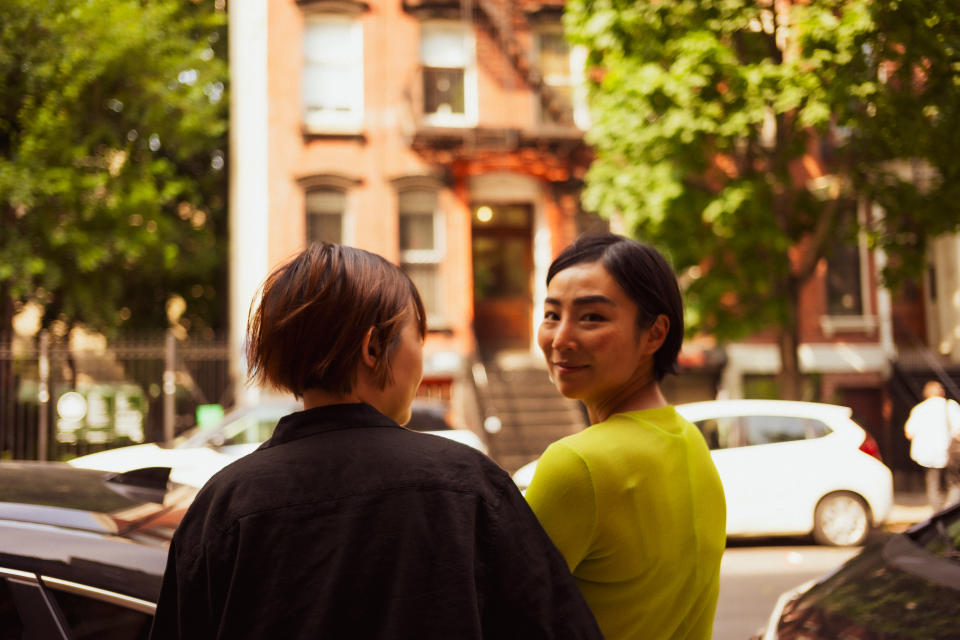
We move on toward the next location, which is the East Village apartment where Nora and her husband Arthur, played by John Magaro (Not Fade Away, First Cow) live. As we make our way to the “box of beer corner” at the intersection of East 2nd Ave and 1st St, Song and Lee are reminiscing about several of the other directorial tricks and hacks that the first-time filmmaker used to foster a sense of intimacy between the performers on set. For example, when she was giving notes to Greta and Teo on set, she’d speak to them in Korean “because the whole crew would hear me giving a note, and then everyone would be huddled around the monitor, going, ‘So did Greta take the note? Did she do a good job?’ I wanted it to be secret. What’s happening with the actors and me, or with Greta and Teo, in terms of the performances — that’s between us. I did that when we shot later in Korea, too; I’d give Teo his notes in English. Actors have to bring up all this emotion and pretend 100 people aren’t watching them. I wanted to make that a little easier.”
“But it’s honestly so incredible for a first-time director to understand that, though,” Lee says. “I’ve been doing this for almost 20 years, and that sort of protection is not a natural sensibility to most of the filmmakers I’ve worked with. Celine would say, ‘When they see each other again, I can’t show fireworks going off behind them. All of that connection needs to be conveyed by you two.’ We had to communicate this through our expressions and our body language, our interactions. And she figured out how to give us that extra thing to help us do that. I think that’s one of the reasons people have really responded to the film the way they have.”
“Yeah, we’d often say there were three languages we spoke on set,” Song adds. “There was English, Korean, and silence. We had a number of scenes where the characters aren’t saying much to each other, but there’s a lot of information being communicated between them. Those silences had to be articulated — they’re there for a reason. Otherwise, it’s just a scene where two people aren’t talking.”
Past Lives spends the initial part of its last act showing you the respective lives that these characters now lead: Nora has settled into a fulfilling creative career and a marriage, Hae Sung spends his day working a white-collar office job and hanging out with his buddies at night. By the time the latter comes to New York to visit his old friend, we have a good idea of the stakes. He’s a major figure from Nora’s past. The green door at the top of the stairs in the middle of the East Village represents her present. No one knows what the future will hold after Hae Sung shows up.
“I did something similar with the first time Hae Sung and Nora’s husband meet at their place,” Song says, as she and Lee stop to take a few pictures on the stoop. “I sort of purposefully kept them apart, and Greta would talk to Teo and John about what it was like to rehearse with the other. They developed this separate chemistry with her, and a sort of respective jealousy around the other. So when Hae Sung comes into the apartment at the end of the day he’s spent with Nora, and Arthur meets him — that’s the first time Teo and John are meeting, really. And each of them have this idea of the other in relation to Greta as well as her character.”
“Did you use the first take on that one?” Lee asks, curious.
“Yes, I did,” Song answers.
There’s nothing particularly unique about this stoop or this street — which, the director says, is exactly why it was perfect. She wanted it to look like the sort of modest place two writers would actually live on (it’s not that different on the outside from where her and her husband live, Song notes), and was thrilled when her location scout stumbled across this stretch during a stroll through the neighborhood. The same thing happened in Seoul, she notes, when he went looking for a place where they could film the farewell between the child actors playing the younger versions of Nora and Hae-Sung. Only it happened quicker. “It was the first place they took him to in Korea,” Song says, “and he immediately called me and said, ‘You’re going to think I’m crazy, but I found it. When I got there and saw it, I was just like, are you kidding? It’s fucking perfect!”
Her only worry was that the street in Korea was a little too picturesque, but then she realized that it had to stick in the viewer’s head long after they got to know the adult Nora and Hae Sung. “That’s why I kept it brief,” she says. “I knew it would register, so when we get to that tracking shot near the end…”
“Let’s wait until we get to the bar to talk about that,” Lee says.
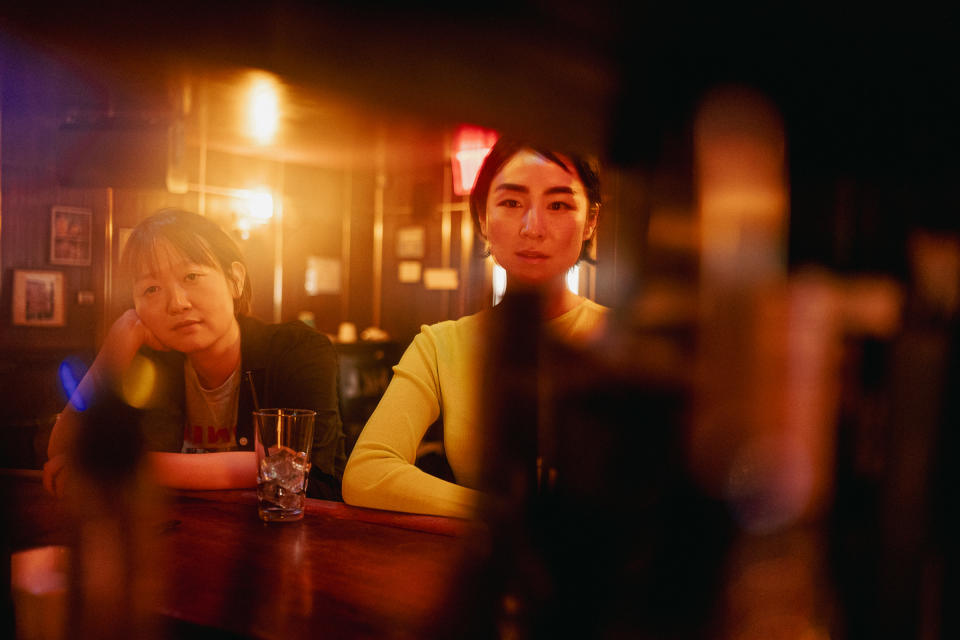
We head to the last stop, which is actually the first place you see in Past Lives: the Holiday Cocktail Lounge. The movie opens on Nora sitting between Hae Sung and Arthur at a bar, as seen from across the room; unseen patrons guess what the trio’s relationship is over the soundtrack. By the time this scene is reprised late into the movie, audiences know Nora’s connection to both of these men, and why her expression seems both happy and sorrowful. It’s essentially a recreation of the exact experience that inspired the film in the first place. And while the IRL version of that encounter ended at Please Don’t Tell, the Downtown Manhattan speakeasy best known for requiring patrons to enter via a fake phone booth, Song knew she wanted to film the movie’s equivalent at the Holiday. You could not ask for a more New York-looking drinking establishment to end an evening.
Both Song and Lee have a fondness for the place, as well as the neighborhood and New York in general. The actor recalls living in a nearby apartment when she was trying to get her career off the ground, auditioning and working theater jobs, exploring the city and “having the occasional crying jag at Kettle of Fish.” For Song, it’s where she came to realize her dream of being a writer. And neither could shake off their own history with the city when they were filming here, which — like the history of anyone who’s lived here for even a small amount of time — is filled with both good and bad memories.
“I’ve said this before, but there were two divas on the set, and neither were actors,” Song says. “It was our 35mm camera, and New York. There’s so much planning you need to do for a film to work, all those trucks and lights and the crew, and this city fucking thrives on unpredictability. But this is also a place with such incredible charisma. I compare living and working in New York to having a relationship with a volatile, amazing, really hot musician. The highs are high, the lows are super low, and sometimes you’re like, I never want to see this person again. Then all of a sudden, the light hits the sidewalk or you see somebody go by on a bike with a dog on their head, and you’re like, I just love this place so much. New York does not need me. If I left, New York would be like, ‘Cool. I guess we’re not together anymore, then.’ Which somehow makes you love when it loves you back in those little moments that much more.”
“And when you leave and you no longer have that daily struggle to do something as get groceries back to your apartment, you kind of miss it… partially because then you’re just left with having to deal with your thoughts,” Lee jokes. “But it’s like, you had to film this movie here. That thing about New York being it’s own character is so cliché, but…”
“New York is your scene partner,” Song says. “When we filmed the twentysomething Nora going across the bridge into the city for the first time…”
“We showed an early cut of the movie to some friends,” Lee remembers, “and he said that when he saw that shot of me crossing the bridge into Manhattan, he actually started crying. Which I was so happy to hear, because I remember when I read that scene in the script, it made me tear up. It’s such a palpable feeling you get when you take that ride in, that sense of promise…”
The subject of crying, not surprisingly, leads them to talk about what may be the most notable sequence in Past Lives: a long tracking shot that comes right before the end credits, in which Nora and Teo wait for a car. It goes from the doorway to Nora’s apartment to roughly 100 yards away and back again — the “this was our everything” bit of everyday NYC that Lee referred to earlier. Song always knew in her head that this was how the movie would effectively conclude, and that it would be an echo of a scene involving the 12-year-old Nora and Hae Sung; she even lit both shots the same way, just to make the echo across space and time clear. It’s a sequence that’s near-silent, fairly simple in what it’s showing you, and profoundly devastating. And it was, by Lee’s own account, the sequence she knew she had to get just right to make the film come together.
“I’m reluctant to attach a metaphor to any of this,” she says. “But if I had to compare it to anything, it’d be BASE jumping or skydiving. You know the date is approaching, you’ve prepped the best you can, you have all of the equipment and gear in place, and it’s really about knowing where to start and where your end mark is. And yet…” Lee laughs. “And yet, it’s just a total leap of faith into the abyss. You’re doing it with someone who’s just as committed to trying to capture an aspect of the human experience, and man, it was just rough. You fool your body into thinking it’s in an emotional state, right? I’d fooled my body into thinking I was storming the beaches at Normandy. It was just brutal.”
“We’d talked a lot about it,” Song says, nodding. “But there’s talking about it and there’s actually doing it. I kept saying, ‘I know what I’m asking you is impossible…’”
“‘What you have to do is impossible, Greta… OK, now back to one!’” Lee says, as Song breaks into a loud laugh. “We did six takes, I think. And I was just dehydrated by the end. Like, dry as a bone. Celine was really delicate about asking for more takes, but at a certain point, I think I just said…”
“‘I’m done,’” Songs says. “And then, I knew I had my movie.”
“And we all went to drink a ‘box of beer’ on the corner,” Lee replies, making air quotes. Song puts her head on Lee’s shoulder, and the actor puts her arm around her director. They’re happy to be in each other’s company again. After Lee changes her outfit and the two take pictures with the bartender — who tells them people have been stopping by to ask if this is, in fact, the bar in Past Lives; he jokes that they’ve now become a tourist trap — the two head out into the brightness of the late afternoon. They smile. And for a quick second, they both look like they know New York doesn’t need them, but still loves them anyway.
Production Credits
(Greta Lee) Hair by JUNYA NAKASHIMA. Makeup by Tyron Machhausen using CHANEL Beauty at The Wall Group. Styling by DANIELLE GOLDBERG. Outfit by Tory Burch
Best of Rolling Stone

